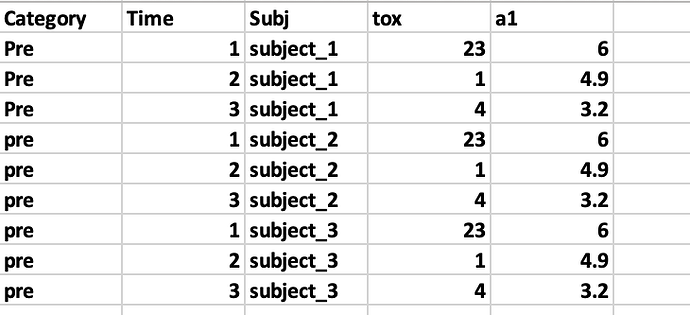I'm trying to convert data from wide to long form with tidyr, but also open to other options. This is fake dataset with repeating values but it has the same structure as real dataset
structure(list(Category = c("Pre", "Pre", "Pre", "post_med_1",
"post_med_1", "post_med_1", "post_med_2", "post_med_2", "post_med_2"
), Time = c(1L, 2L, 3L, 1L, 2L, 3L, 1L, 2L, 3L), Subj_1_tox = c(4.2,
5, 2.3, 4.2, 5, 2.3, 4.2, 5, 2.3), Subj_2_tox = c(23L, 1L, 4L,
23L, 1L, 4L, 23L, 1L, 4L), Subj_3_tox = c(6, 4.9, 3.2, 6, 4.9,
3.2, 6, 4.9, 3.2), Subj_1_a1 = c(4.2, 5, 2.3, 4.2, 5, 2.3, 4.2,
5, 2.3), Subj_2_a1 = c(23L, 1L, 4L, 23L, 1L, 4L, 23L, 1L, 4L),
Subj_3_a1 = c(6, 4.9, 3.2, 6, 4.9, 3.2, 6, 4.9, 3.2)), class = "data.frame", row.names = c(NA,
-9L))
The confusing part for me is how in one call could I convert the tox columns and the a1 columns to long form (with each having their own tox and a1 columns with values inside) and maintain the category and time columns. First off is the regex for the name pattern. I have looked up regex patterns, but not clear how to get it and second how to include 2 different value columns in 1 call?
Basically something like this in one call
df_longer<-df %>%
pivot_longer(
cols=contains("tox") & contains("a1"),
names_to = c("subject", "tox", "a1"),
names_pattern = "(Subj_['all_numbers') (tox and a1) "
values_to = c("tox_value", "a1_value"))
With the end result being the Subject(#) being in one column called subject and the tox values and the a1 values being in other columns. Is it possible to do this in one call? I'm also open to other solutions but am trying to learn tidyr more
The final result should look something like this, but values are not right in this one but the other parts are accurate.
